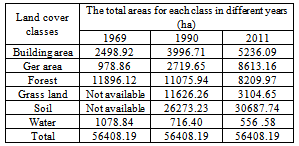-
Paper Information
- Next Paper
- Paper Submission
-
Journal Information
- About This Journal
- Editorial Board
- Current Issue
- Archive
- Author Guidelines
- Contact Us
American Journal of Geographic Information System
p-ISSN: 2163-1131 e-ISSN: 2163-114X
2013; 2(3): 27-36
doi:10.5923/j.ajgis.20130203.01
Applications of Remote Sensing Techniques and GIS for Urban Land Change Studies in Mongolia
D. Amarsaikhan1, Ts. Bat-Erdene2, J. Janzen3, Ch. Narantsetseg4, M. Ganzorig1, B. Nergui1
1Institute of Informatics, Mongolian Academy of Sciences, av.Enkhtaivan-54B, Ulaanbaatar-51, Mongolia
2Department of Geography and Tourism, Mongolian State University of Education, Ulaanbaatar-46, Mongolia
3Institute for Geographische Wissenschaften, Freie Universität Berlin, Malteser Strasse 74-100, D-12249 Berlin, Germany
4School of Geography and Geology, National University of Mongolia, Ikh Surguuliin gudamj-6, Ulaanbaatar-46, Mongolia
Correspondence to: Ts. Bat-Erdene, Department of Geography and Tourism, Mongolian State University of Education, Ulaanbaatar-46, Mongolia.
| Email: |  |
Copyright © 2012 Scientific & Academic Publishing. All Rights Reserved.
The aim of this study is to compare the changes that occurred in the main urban land cover classes of Ulaanbaatar, the capital city of Mongolia during centralized economy (i.e. 1969-1990) with the changes occurred during market-based economy (i.e. 1990-2011) and describe the socio-economic reasons for the changes. For the analysis, multitemporal high resolution optical and microwave remote sensing (RS) images as well as geographical information system (GIS) and census data sets are used. To extract the reliable urban land cover information from the available RS data sets, a refined maximum likelihood classification (MLC) algorithm that uses spatial thresholds defined from the contextual knowledge is constructed. Before applying the classification decision rule, some ordinary and advanced image fusion techniques are applied to the selected RS data sets, in order to define the most efficient fusion method that can create the best color image to be used for training sample selection as well as for defining the contextual knowledge. Overall, the analysis indicates that during the periods of both centralized and market-based economies the most significant change occurs in the ger area of Ulaanbaatar city and the main reason for this is the growing population and shortage of modern accommodation.
Keywords: Urban Land Cover, Change Analysis, RS, GIS, Classification
Cite this paper: D. Amarsaikhan, Ts. Bat-Erdene, J. Janzen, Ch. Narantsetseg, M. Ganzorig, B. Nergui, Applications of Remote Sensing Techniques and GIS for Urban Land Change Studies in Mongolia, American Journal of Geographic Information System, Vol. 2 No. 3, 2013, pp. 27-36. doi: 10.5923/j.ajgis.20130203.01.
Article Outline
1. Introduction
- At present, because of the rapid increase in world population and the irreversible flow of people from rural to urban areas, the urbanization and urban sprawl have become the common problem of governments and decision-makers in both developed and developing countries[1]. As it is known, the developed countries have a higher percentage of urban inhabitants than the developing countries. However, rapid urbanization process is mainly occurring in less developed countries, and it is expected that in future most urban expansions will occur in the developing world. Mongolia, as many other developing countries, has problems with the urban expansion and the growth of population in the main cities. For example, within the last two decades, Ulaanbaatar, the capital city of Mongolia has been significantly expanded due to mainly enormous migration of people from rural areas as well as some development activities[2].To prevent from the rapid urban expansion, especially from the unplanned urbanization process, urban planners and decision-makers need to regularly evaluate the current development procedures using updated urban planning maps. However, many city planners in developing countries have a lack of the updated maps and often they posses old data which is not relevant for current decision-making[3,4]. One of the possible solutions could be the use of space images, because present satellite RS has the huge potential of providing accurate spatial information over a large area in a short time sequence. Also, it has been broadly recognized as a powerful tool for detecting the land use and cover changes [5-9]. Over the last years, the costs for the primary satellite data sets have considerably decreased. Meanwhile, massive archive of high resolution RS images with acceptable resolution has been available free of charge in different Internet sites. It means that it is possible to extract from RS images, different thematic information in a cost effective way and use it for different urban related studies.As it is known from a city planning record of Mongolia, much of its urban growth has taken place since the middle of 1970s, because, at that time, the government encouraged migration to urban areas, specifically to Ulaanbaatar. Although, this encouragement was based on the belief to increase the industrialization and productivity, the government made a strict control over migration, and only those who found jobs could move to Ulaanbaatar city. To accommodate the growing population in the capital city, the government mainly constructed high-rise apartment blocks. However, the number of apartments fell well short of satisfying the demands of the growing population. Therefore, when rural people migrated to Ulaanbaatar, set up gers (Mongolian national dwellings) for their accommodation. The rapid political changes of 1990 marked the beginning of Mongolia's efforts to develop market economy. It started to change the lives in the society very rapidly and the government stopped controlling of many things[10]. For the isolated rural people, it had become very difficult to reach the central market. Meanwhile, many things started to centralize in the capital city and Ulaanbaatar had become a dream location for many rural people. Therefore, many rural families moved officially and unofficially to Ulaanbaatar. As a result, the population of Ulaanbaatar increased significantly and the city area expanded drastically.Generally, it should be interesting to study the urban growth in Ulaanbaatar city comparing the growth thatoccurred during the main industrialization period (1969–1990) when Mongolia had a centralized (i.e., socialist) economy to the changes that occurred during the market economy. The previous study, conducted by Amarsaikhan et al.[4] compared the changes occurred in the main land cover classes of selected part of the capital city during centralized economy with the changes occurred during a certain period of market economy (i.e., in between 1990 and 2001) using multitemporal optical images. In the present study, the changes that occurred in Ulaanbaatar between 1969 and 1990 have been compared with the changes that occurred between 1990 and 2011 using historical GIS data as well as multisource RS images, and the socio-economic reasons for the changes were described. Such comparisons could be helpful for the planners to consider directions of the urbanization process in the city.To extract the reliable urban land cover information from the selected RS data sets, a refined MLC algorithm that uses spatial thresholds defined from the contextual knowledge was used. Before applying the classification decision rule, some some ordinary and advanced image fusion techniques such as multiplicative method, intensity–hue–saturation(IHS) transformation, Brovey transform, principal component analysis (PCA), wavelet-based fusion and Ehlers fusion were applied to the selected RS data sets, in order to define the most efficient fusion method that creates the best color image used for training sample selection as well as for defining the contextual knowledge.
2. Test Site and Data Sources
- As a test site, Ulaanbaatar, the capital city of Mongolia has been selected. Ulaanbaatar is situated in the central part of Mongolia, in the Tuul River valley, at an average height of 1350m above sea level. By 2011 statistics, population of the city was counted at about 1,250,000 inhabitants[11]. Today’s Ulaanbaatar is the main political, economic, business, scientific and cultural center of the country. In addition, the city is home to the central government and its bureaucratic structure, and the most prominent public and private institutions of higher learning and best medical services.The study area chosen for the present study covers an area of 28kmx20km. It covers the majority of the area belonging to the capital city, although there are some areas extending outside of the selected image frame. For the selected area, it is possible to define such classes as built-up area, ger area (Mongolian traditional dwelling), forest, grass, soil and water. The built-up area includes buildings of different sizes, while ger area includes mainly gers surrounded by fences.
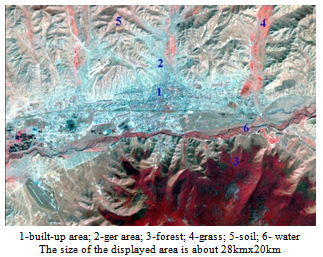 | Figure 1. 2011 Landsat TM image of the selected part of Ulaanbaatar city |
3. Radiometric Correction and Georeferencing of the RS Images
- At the beginning, all the available images were thoroughly analyzed in terms of radiometric quality and geometric distortion. For the SPOT PAN data of 1990 some line dropouts occurred and for the correction, averaging of the upper and lower lines of the lines that had to be corrected was applied. In case of the multispectral images, band 1 (i.e., blue band) of both Landsat TM data had noise from the atmosphere and it was difficult to correlate their radiometric values with other bands. Therefore, they were excluded from the analysis. Moreover, as band 6 of TM and bands 61 and 62 of ETM are thermal bands, they were excluded from the further analysis, too.In case of the SAR images, as they have a speckled appearance, radiometric correction should be based on the speckle reduction techniques. In this study, four different speckle suppression techniques such as local region, lee-sigma, frost and gammamap filters[12] of 3x3 and 5x5 sizes were compared in terms of delineation of urban features and texture information. After visual inspection of each image, it was found that the 3x3 gammamap filter created the best images in terms of delineation of different features as well as preserving content of texture information. In the output image, the speckle noise was reduced with very low degradation of the textural information.In order to merge data sets with different spatial resolutions, a high geometric accuracy and good geometric correlation between the data sets are needed. Initially, the SPOT PAN image and Landsat TM data of 1990 were georeferenced to a UTM map projection using a topographic map of 1984, scale 1:50 000. The ground control points(GCP) have been selected on well defined cross sections of roads, streets and other clearly defined sites. In total, 16 more regularly distributed points were selected. For the transformation, a second order transformation and nearest neighbour resampling approach have been applied. The root mean square (RMS) errors were 0.98 pixel and 0.83 pixel for the SPOT and Landsat images, accordingly. Then, the Landsat TM data and Envisat image of 2011 were georeferenced to a UTM map projection using the same topographic map of 1984. The transformations were conducted by the use of a second order transformation and nearest neighbour resampling approach and 18 more regularly distributed GCPs were selected. The RMS errors were 0.71 pixel and 1.09 pixel for the Landsat and Envisat images, respectively. In all cases, an image was resampled to a pixel resolution of 18m.
4. Image Fusion
- In the present study, the selected test site represents complex urban environment. In the area, the three main classes such as building area, ger area and soil have similar or mixed spectral characteristics. Therefore, in order to enhance the spectral and spatial variations of these statistically overlapping classes as well as to merge the images with different spatial resolutions, different image fusion techniques have been compared. Within the framework of the study, it was decided that the fused image should be used for determining the sites for the training sample selection and also for defining the contextual knowledge about the classes of objects.The image fusion is a process, which integrates different images from diverse sources to obtain more information, considering a minimum loss or distortion of the original data. In the case of the present study, for the urban areas, the optical images provide the information about the spectral variations of different urban features, while the radar image provides structural information about buildings and street alignment due to the double bounce effect. Over the years, different data fusion techniques have been developed and applied, individually and in combination, providing users and decision-makers with various levels of information. Generally, image fusion can be performed at pixel, feature and decision levels[4,13].
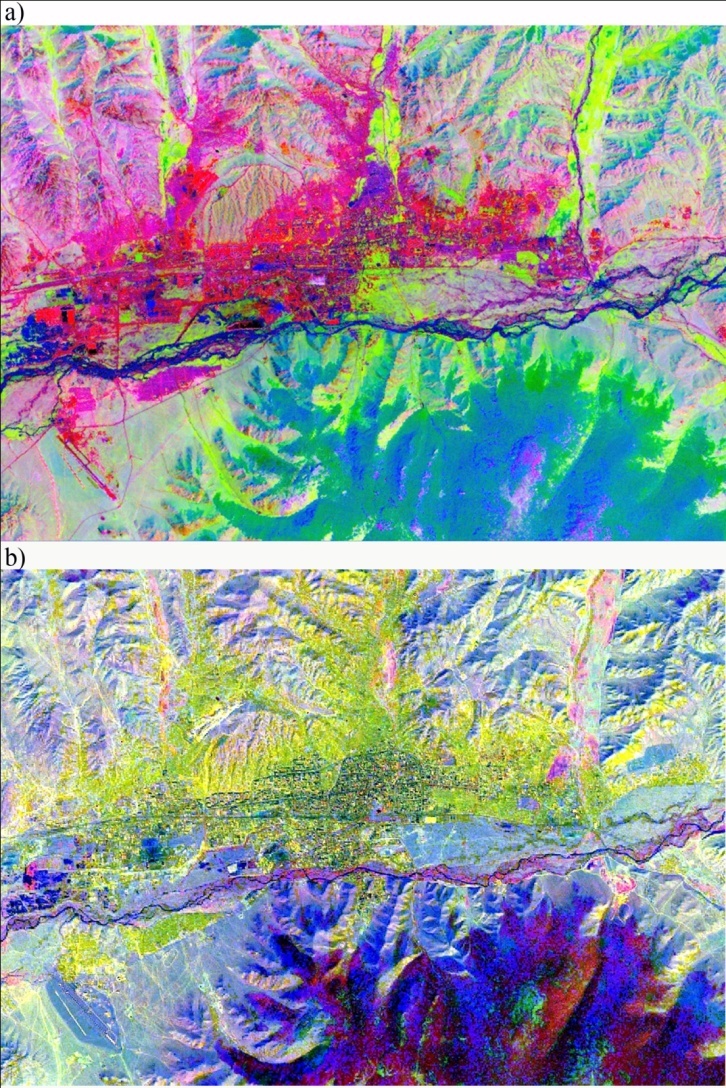 | Figure 2. Comparison of the images obtained by the PCA applied to 1990 data sets (a) and wavelet-based fusion applied to 2011 data sets (b) |
5. Classification of the Images
- For several decades, single-source multispectral RS data sets have been successfully used for land cover mapping and for the generation of thematic information, diverse supervised and unsupervised classification methods have been applied. Unlike single-source images, data sets from multiple sources have proved to offer better potential for discriminating between different land cover types. Many authors have assessed the potential of multisource images for the classification of different land cover classes[19-21]. At present, the most commonly used RS data classification techniques are parametric and non-parametric methods, Dempster–Shafer theory of evidence, neural networks, decision tree classifier, and knowledge-based methods [22-24].In recent years, rapid and timely mapping of urban areas, specifically at regional and global scales has become an important task for many urban planners. This is associated with the rapid urbanization process, because the planners and decision-makers need to evaluation the relatedenvironmental and social problems[25]. However, in most cases urban areas are complex and diverse in nature and many features have similar spectral characteristics and it is not easy to separate them by the use of common feature combinations or by applying ordinary techniques[26]. For the successful extraction of the urban land cover classes, reliable features and an efficient classification technique should be used. In the present study, for the classification of urban land cover types, a refined statistical MLC algorithm has been constructed. The method can be successfully used for separation of classes in both single-source and multisource images.
5.1. The Selected Features and Evaluation of the Training Signatures
- Generally, in the classification process, it is desirable to include only the features in which the signatures of the selected classes are highly separable from each other in a multidimensional feature space. In case of the present study, as the features, the first three PCs defined from RS data sets of 1990 and the first four PCs defined from data sets of 2011 have been selected because, they contained more than 98% of the total variance.In the current study, to define the sites for the training signature selection, a similar approach applied in Amarsaikhan et al.[4] has been used. Initially, from the multitemporal PC images, several areas of interest (AOI) have been selected for each available class (i.e., building area, ger area, forest, grass land, soil and water) using the contextual knowledge. The contextual knowledge was defined on the basis of the spectral variations of the land surface features as well as the texture information delineated on the fused images. The separability of the selected training signatures was firstly checked in feature space and then evaluated using Jeffries–Matusita distance[12] and it revealed that high statistical overlaps exist between the classes: building area and ger area. It is obvious, because ger families usually have houses beside their gers. Therefore, these two classes have very similar spectral characteristics. Then, the samples which demonstrated the best possible separability were chosen to form the final signatures. The final signatures included about 126-498 pixels.
5.2. The Refined MLC Method
- The MLC is the most widely used classification technique, because a pixel classified by this method has the maximum probability of correct assignment[27]. The decision rule assuming Bayes' rule can be written as follows:
 | (1) |
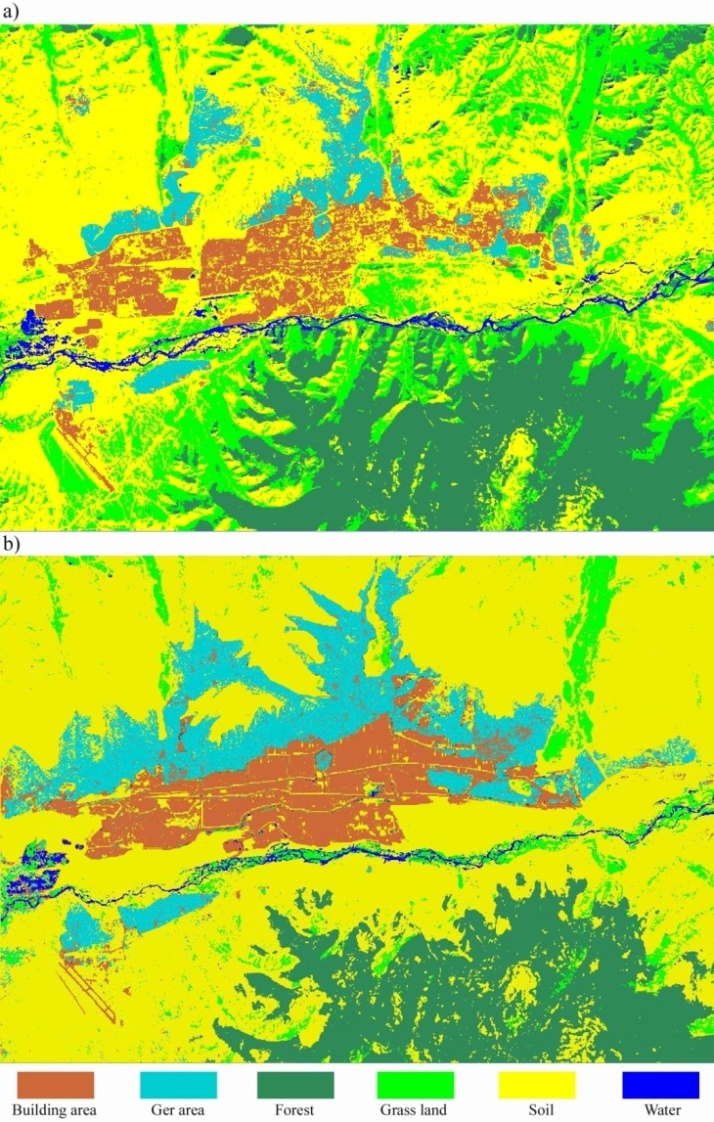 | Figure 3. Comparison of the classification results for the selected classes. (a) Classified image using 1990 data sets, (b) Classified image using 2011 data sets |
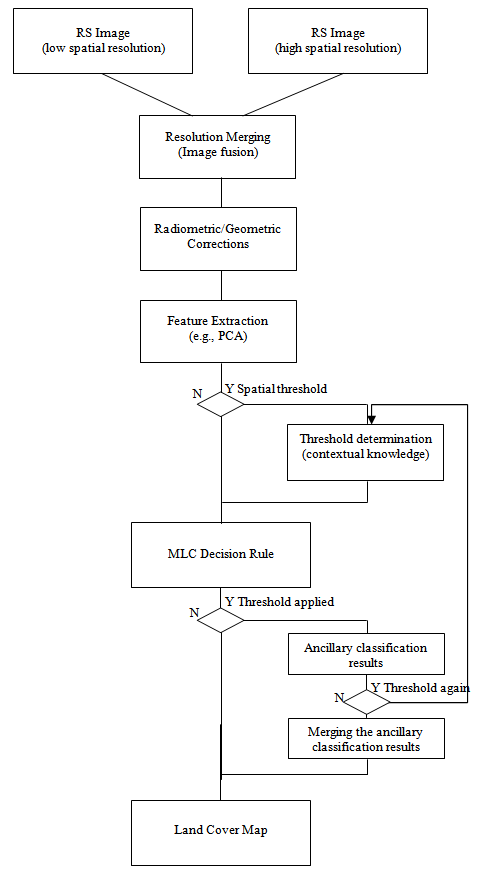 | Figure 4. A general diagram for the refined parametric classification |
6. Urban Land Cover Change Analysis
 | Figure 5. Digitized topographic map of Ulaanbaatar area of 1969, scale 1:50 000 |
|
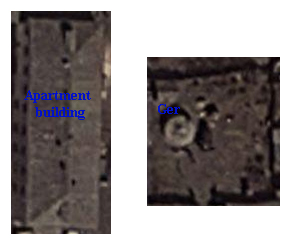 | Figure 6. Comparison of the areas covered by a single high-rise apartment building and a ger family (Quickbird image of 2011) |
7. Conclusions
- The overall purpose of the research was to compare the changes that occurred in the main urban land cover classes of the Mongolian capital city during a centralized economy with the changes occurred during a market economy and describe the socio-economic reasons for the changes. For this aim, multitemporal high resolution optical and microwave RS images as well as GIS and census data were used.To extract the reliable urban land cover information from the selected multisource RS data sets, a refined maximum likelihood classifier that uses spatial thresholds defined from the contextual knowledge was constructed. Before applying the classification decision rule, some ordinary and advanced image fusion techniques were explored in order to define the most efficient fusion method that could create the best color image used for training sample selection as well as for defining the contextual knowledge. It was seen from the classification results that the spatial thresholds defined from the contextual knowledge could considerably improve the performance of the classification and for the accurate classification, proper spatial thresholds should be applied.As could be seen from the urban land cover change analysis, during the periods of both centralized and market-based economies significant changes occurred in the ger area of the city and ger districts mainly extended in northern and eastern parts of the Ulaanbaatar city. Moreover, as seen from the analysis, during all this time, the natural resources such as forest and water had been reduced. Furthermore, it was seen that a spatial resolution of the used RS data sets allowed to conduct the analysis at a regional scale and the results could be useful for the planners and decision-makers to consider directions of the urbanization process in the capital city.
 Abstract
Abstract Reference
Reference Full-Text PDF
Full-Text PDF Full-text HTML
Full-text HTML